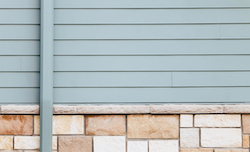Concrete, brick, stone, stucco, EIFS/DEFS, wood, vinyl—there are so many kinds of exterior finishing for homes and commercial buildings. The types of walls you see are determined by the climate, the building’s use and design, and the taste of the owner, among other variables. You aren’t likely to see vinyl siding on homes in Arizona or Utah, while buildings in wetter regions like the Midwest and Northeast are rarely finished with stucco. But what’s the difference, and how does a contractor or architect help their client make a good decision? Here is some information about some different types of exterior walls that might be helpful to have in your back pocket.

What Material Is Used for Exterior Walls?
There are seven basic types of exterior wall materials: quarried stone, vinyl, fiber cement, brick, wood, stucco, and composite.
- Quarried Stone: Stones like marble or limestone are the most durable wall materials, but it is rare to see an exterior finished entirely with stone today. Instead, this is usually a feature of the façade used in combination with other finishes to achieve a desired aesthetic.
- Vinyl: Vinyl siding is affordable, durable, and comes in a wide variety of styles, colors, and textures. This is a popular choice to suit diverse residential and commercial uses.
- Fiber Cement: Fiber cement is incredibly strong and versatile, and can be made to look like other finishes such as stone or stucco. It is also heavy and somewhat brittle, meaning it might not be ideal for use in all cases.
- Brick: A brick exterior finish doesn’t require a building to be constructed from brick. Brick veneer can deliver the look and feel of bricks in any color, without the natural water absorption of traditional brick.
- Wood: Wood can provide a long-lasting finish—especially when painted or stained—which helps with resisting rot, pests, the sun, and other factors of the environment that affect this material far more than others. Of all the cladding types, wood is also the most prone to fire damage.
- Stucco: Stucco is similar in composition to fiber cement and can last 50+ years with proper installation and maintenance. The application has historically been time- and labor-intensive, but new products like Structa Wire enhance the performance and reliability of stucco with less time and experience required to install.
- Composite: The name “composite” refers to a mixture of materials—commonly wood, resin, PVC, and other polymers. Though this is a newer exterior finishing material on the market, and thus is not as proven as other finishes, there are fantastic results coming from EIFS/DEFS installations across the United States.
The biggest reasons a building needs an exterior finish are: (1) sun/weather protection; and (2) moisture resistance. A system for drainage and ventilation between the siding or cladding and the wall is important to prevent mold and rust, extend the life of the finish, and avoid costly callbacks or unhappy customers.
House Exterior Wall Types
In addition to stone, vinyl, fiber cement, brick, wood, stucco, and composite materials, you might also see clay tile or metal on the outside of a house. According to the U.S. Census Bureau’s 2020 Survey of Construction, the most common exterior finish for a new home was stucco (28%), followed closely by vinyl siding (26%). Those two finishes alone were used on over half the new homes that year. Fiber cement siding (21%) and brick/brick veneer (19%) made up a significant portion of the remainder, with wood (4%) and stone (1%) in the minority.
Types of Exterior Walls for Commercial Buildings
The exterior of a commercial building can be made of any common finishing material: stucco, vinyl, fiber cement, brick, wood, or stone. Metal siding, panel siding, longboard siding, wood panels, and composite are additional materials that could be used to finish a commercial building exterior.
What Is the Most Common Type of Exterior Finish?
Stucco is the most common type of exterior finish in dry climates of the United States. For residences and some commercial buildings in damp climates, vinyl siding is most common. EIFS/DEFS, wood panels, fiber cement, concrete, and metal are other finishes you will see on commercial buildings.
Simplify Stucco Installation With the Easy Embedment System™
Stucco has historically taken a lot of experience to install. ClarkDietrich provides products that enable easier and faster installation of stucco, even by professionals with less experience. We see that labor shortages have contractors working hard, and we want to deliver options that save time, reduce risk, and improve outcomes for the builder and the current or future owner. Learn more about our Easy Embedment System, which provides greater embedment, faster than using the same practices as standard lath. This is just one of the ways ClarkDietrich helps with framing, interior finishing, and exterior finishing. If there is more we can do for you, please let us know.